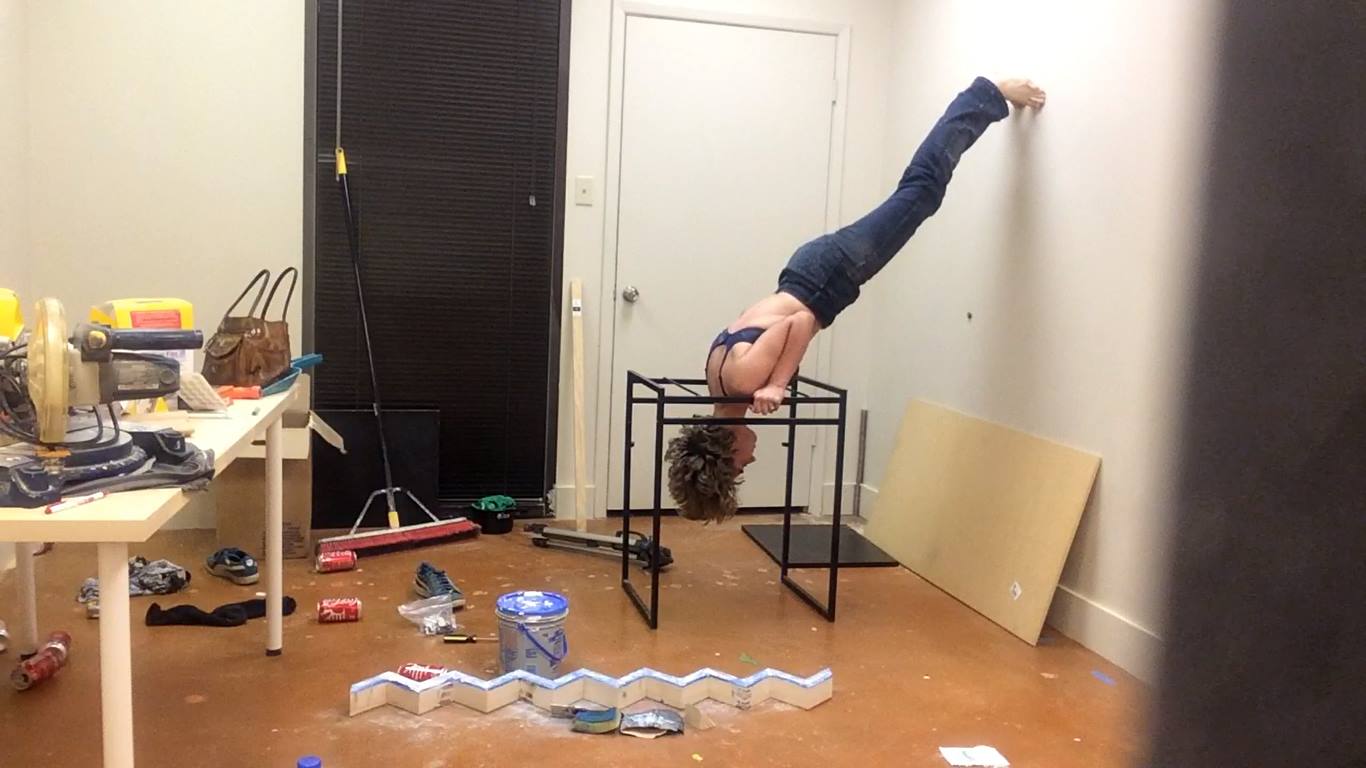“It felt like 2017 was the year of Sisyphus,” Karen Weiner offers in her introduction to Iva Kinnaird’s current solo show at The Reading Room. A Two Page Paper on Impasse, on view through March 24, is one of Kinnaird’s first solo shows, although the North Texas born, Houston-based artist has not gone unnoticed by Texas-based critics.
“I have all this work that sort of related to that story (Sisyphus),” Kinnaird says of her response to Weiner’s prompt. “And that’s sort of the groundwork for this show, how work can feel like this uphill battle, never-ending. It’s sort of like a job description for me as an artist.”
The Reading Room’s small space is dominated by a Walmart shopping cart filled with bricks Kinnaird procured from Craigslist, where one can find hundreds of sellers begging for someone to take used bricks off their hands. Kinnaird has constructed Broke, Please Advise on several occasions now and has found a different breaking point each time. In this incarnation, the foot of the cart has collapsed under the weight of the bricks, leaving a number of them strewn haphazardly on the gallery floor.
Like a great deal of Kinnaird’s work, the piece references the frustration and absurdity of art-making. The ill-fated stacking of bricks in the cart amount to inevitable disappointments and defeats that come along with choosing a life spent in attempt to shoehorn ideas into objects. But the work, like Kinnaird’s practice as a whole, transcends its immediate environs. With humor, the artist gestures past art’s absurdity toward life’s absurdity.
“If you’re on the right track you’re never really going to get where you’re going. Like, you’re always on this path, you’re always failing and if you succeed that might almost be worse, because then what would you do? Sisyphus can never succeed because then what?” she says.
It could be really depressing, this fixation on futility. In Kinnaird’s playful hands, the circular nature of human effort takes on a humorous tone. It’s a necessary comedy masquerading as art.
Take New Ikea Furniture for example, a video piece of Kinnaird in her studio assembling IKEA furniture and killing time by climbing on the partially assembled pieces, contorting her body in impressive acrobatic movements—through a table frame one day, crashing from a ladder to the floor the next.
Kinnaird pokes fun at art’s spectacular seriousness but also demystifies the process for the non-artist, revealing art for what it often really is: a series of failed attempts. In a way, she elevates the down-time many of us take for granted or think of as “wasted,” driven as we are to produce, produce, produce! I’ll let Annie Dillard say it for me, since it bears continual reminder: “How you spend your days is of course how you spend your life.”
Although the physicality of Kinnaird’s work isn’t the most obvious through-line for the show, it’s evident again in her translations of a series of twelve sketchbook drawings into ceramic sculpture. The titular series of wall pieces read a bit like a tactile code or ancient language with abstract forms. Circles, lines, and squares, illustrated in various arrangements, hint at the futile search for success or achievement: Large Impasse, Problem is You, Not My Problem, A Cage You Can Feel, just to name a few.
Apart from futility, Weiner points out the theme of failure in Kinnaird’s work, and really, the two are unavoidably intertwined. Boo- hoo, Nothing Sold, a small-marker drawn illustration of unused sale dots, the red stickers gallerists place on purchased pieces during shows, is the last piece visitors see on their way out of the gallery.
Although much of Kinnaird’s work explicitly addresses the conundrum of artists— the sale dots, her Grad School Dart Board (a traditional dart board she updates every two years to reflect the current rankings of U.S. graduate schools)— it’s often universal. Who doesn’t occasionally realize the absurdity of our all too-brief lives, chained as we are to work we rarely enjoy and obligations we’re unable to shirk?
Another small print, neverending self-imposed goddamn sweatshop, a hashtag-like watercolor evoking a word document (signified by the iconic red spell-check lines) with the title illustrated in blocky text, transcends the artist’s career choice.
“That is sort of the goal, to relate to people,” Kinnaird acknowledges, “I make things as a way of communicating. It’s all personal, it’s all issues I specifically have that just happen to be issues that everyone has. I think about that a lot, I don’t want to make something that people can’t understand, this is, like, my way of talking to people.”
Art by nature is a self-conscious, highly personal endeavor. But the anxiety of the artist seems to have grown, evidenced in the number of process-driven and esoteric works—art-making about art— produced in the 21st century. Kinnaird is remarkably adept at translating her own experiences as an artist into universal truths and experiences. Maybe it’s because she’s not trying to defend her choices, prove her worth, or bolster her art with theory. She’s confident in both art’s meaning to her and its place in the world.





